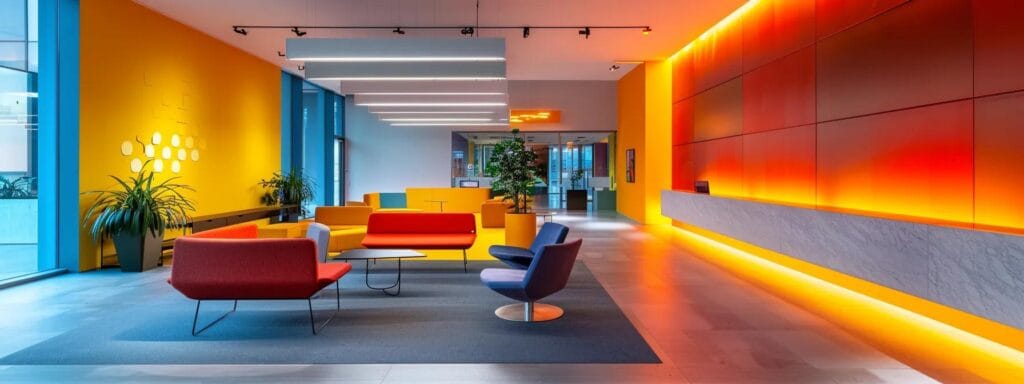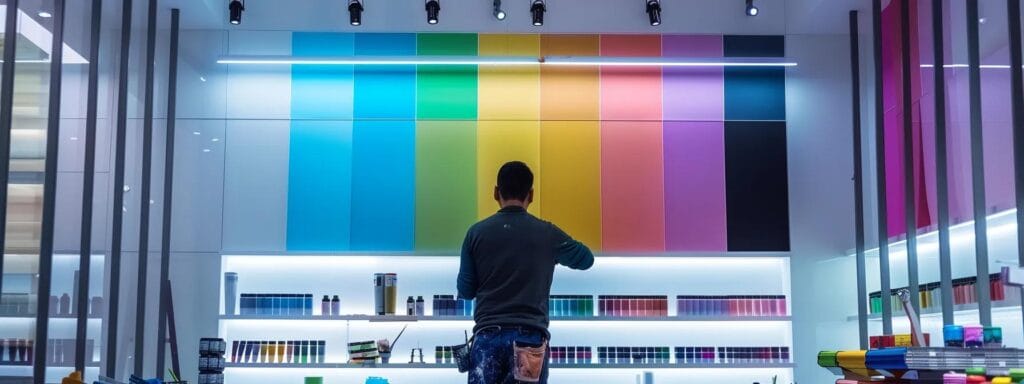
Table Of Contents:
- Create Healthy Workspaces With Low-Voc Paints for Businesses
- Understand the Benefits of Low-Voc Paints for Work Environments
- Choose the Right Low-Voc Paints for Your Business Needs
- Prepare Your Workspace Before Painting With Low-Voc
- Apply Low-Voc Paints Effectively in Your Business
- Maintain Healthy Workspaces Post-Painting With Low-Voc Solutions
- Assess the Long-Term Impact of Low-Voc Paints in Your Business
- Frequently Asked Questions
- Final Thoughts
Create Healthy Workspaces With Low-Voc Paints for Businesses
In today’s modern workspace, creating a healthy, productive, and aesthetically pleasing office is more important than ever. Companies are not only focused on boosting employee morale and productivity but also on the long-term health benefits associated with superior indoor air quality. One significant method to achieve these goals is by using low-Voc paints in business settings. Formulated with reduced chemical emissions compared to conventional paints, low-Voc paints offer environmental, health, and cost-saving benefits that this
outlines—from understanding environmental and health advantages, selecting the right product, preparing the workspace, applying the paint, maintaining the interiors, to assessing long-term impacts.
Low-Voc paints have gained momentum due to increasing concerns over indoor air pollution and stringent Clean Air Act standards. Workspaces painted with these products see improved air quality, reducing symptoms like headaches, respiratory issues, and irritation from chemicals such as formaldehyde. Furthermore, businesses that adopt eco-friendly practices benefit from sustainability incentives and LEED compliance. Overall, low-Voc paints help safeguard employee health and enhance the work atmosphere, contributing to improved productivity and satisfaction.
This article is designed to inform and educate business owners and managers—especially those in Springfield, MO, and surrounding areas like Branson, Ozark, Nixa, Republic, Joplin, and Rolla—about the advantages of using low-Voc coatings. Detailed explanations and practical tips throughout will guide you from product evaluation to application techniques.
Understand the Benefits of Low-Voc Paints for Work Environments
Low-Voc paints offer numerous benefits that impact both the health of individuals and the overall ambience of work environments. With reduced emissions of volatile organic compounds (VOCs), these paints improve indoor air quality (IAQ) and reduce irritation of the eyes, nose, and throat.
Identify How Low-Voc Paints Improve Indoor Air Quality
By dramatically reducing airborne pollutants during and after application, low-Voc paints minimize the emission of chemicals like formaldehyde and acetone, which can trigger allergic reactions and respiratory issues. Studies indicate that workspaces using low-Voc products can see up to a 60% reduction in indoor pollution levels. This improvement is vital in corporate settings where constant exposure to toxins can lead to chronic health issues.
Additionally, low-Voc paints support green building practices and contribute to LEED certification. Their use sends a clear message about a company’s commitment to the Clean Air Act and corporate social responsibility.
Examine the Health Advantages for Employees and Visitors
Improved indoor air quality reduces exposure to allergens and irritants, alleviating symptoms such as chronic headaches, respiratory discomfort, and even stress or depression linked with poor air environments. Fewer chemical exposures mean less skin irritation and eye strain, leading to a more energized workforce, reduced absenteeism, and enhanced productivity. Clients and visitors also benefit from a premium, health-oriented setting.
Learn About the Environmental Impact of Using Low-Voc Options
Low-Voc paints help lower overall air pollution by limiting the release of hazardous organic compounds. This reduction supports sustainability initiatives and green building practices, aligning businesses with environmental standards required by the Clean Air Act. Furthermore, many low-Voc products are manufactured using processes that produce less toxic waste, helping companies reduce their environmental footprint and build better community relations.
Discover Cost-Saving Opportunities Linked to Low-Voc Paints
Although low-Voc paints may have a higher upfront cost, their long-term financial benefits are significant. Their insulating properties can lower heating and cooling costs, while improved employee health reduces sick days and associated expenses. Moreover, achieving LEED certification and other eco-friendly initiatives may qualify companies for tax incentives and rebates, further offsetting initial investments.
Investigate the Aesthetic Appeal of Low-Voc Color Choices
Low-Voc paints come in a range of finishes—from matte to eggshell and gloss—that maintain both durability and color retention without sacrificing design flair. The availability of vibrant, nuanced colors allows business owners to harness color psychology; cool shades like blue and green promote calm and focus, while warm tones such as yellow can inspire creativity. This balance of aesthetics and health benefits makes low-Voc paints a versatile choice for any workspace.
Analyze Compliance With Local Regulations Regarding Paint Usage
Low-Voc paints are designed to meet or exceed regulatory standards, including the Clean Air Act and local air quality ordinances. Their rigorous certification ensures they contain significantly less organic solvents than conventional options. Using certified low-Voc products demonstrates a company’s commitment to environmental stewardship and can enhance its reputation with clients who value sustainability and safety.
Choose the Right Low-Voc Paints for Your Business Needs

Finding the ideal low-Voc paint requires evaluating technical specifications and practical needs. Brands differ in formulations, finishes, and price points, so it’s essential to consider factors such as durability, maintenance requirements, and compliance with health and environmental standards.
Evaluate Different Brands and Their Low-Voc Product Offerings
Brands vary in performance and price. Leading manufacturers provide data on VOC levels, durability, and drying times along with third-party certifications to validate their claims. When reviewing options, consider products with established track records in commercial settings, ensuring they can withstand high-traffic usage.
Compare Finishes and Textures Suitable for Various Spaces
The choice of finish—whether matte, satin, eggshell, or gloss—depends on both aesthetic and functional requirements. For high-traffic areas, a durable, scrubbable finish may be ideal, while reception areas might benefit from a gloss finish for its visual appeal. Additionally, different textures can hide imperfections or add a tactile dimension to the workspace, making consultation with professionals advisable.
Research Certifications That Indicate Low-Voc Compliance
Look for certifications such as GREENGUARD or Green Seal, which confirm that a product meets strict VOC limits. These certifications provide assurance that the paint is environmentally friendly and safe for daily use in commercial settings. Reviewing Certificate of Analysis (CoA) documents can further verify these claims.
Assess Durability and Maintenance Requirements for Paints
Evaluate a paint’s longevity by considering its performance after frequent cleaning and exposure to high-traffic use. A durable paint that maintains its color and finish over time reduces the need for frequent touch-ups. Reading user reviews and case studies can help gauge how a product performs in similar commercial environments.
Seek Recommendations From Other Businesses in Your Industry
Peer recommendations offer valuable insights into the real-world performance of low-Voc paints. Feedback from nearby businesses or industry networks can reveal practical tips regarding cost-effectiveness, durability, and overall satisfaction that might not be apparent from technical data alone.
Consider Color Psychology in Your Workspace Design
Use color psychology strategically by choosing hues that promote the intended mood and function of each space. Cool colors can foster concentration, while warmer tones can energize creative areas. Selecting the right palette not only complements your brand but also enhances the overall work atmosphere.
Prepare Your Workspace Before Painting With Low-Voc
Proper preparation ensures optimal adhesion and longevity of low-Voc paint. This phase combines physical workspace setup, thorough cleaning, and planning to minimize disruption during painting.
Remove Furniture and Obstacles for Easy Access to Surfaces
Clear the area of furniture and obstacles to allow painters unobstructed access to all surfaces. This also reduces the risk of accidental spills and improves air circulation, which is crucial for proper drying.
Clean Walls and Surfaces for Optimal Paint Adhesion
Before painting, clean all surfaces to remove dust, grease, or residue that might compromise the adhesion of the paint. Using non-abrasive tools and eco-friendly cleaning products ensures that surfaces are well-prepared, leading to a smoother finish and longer-lasting results.
Repair Any Damages or Imperfections Prior to Painting
Address any wall damages—such as cracks, holes, or peeling paint—by sanding, filling, and priming affected areas. A smooth, uniform surface not only improves the final appearance but also enhances the durability of the new coat.
Ventilate the Workspace to Enhance Air Circulation
Proper ventilation speeds up drying and disperses residual fumes. Open windows and use fans to maintain healthy air circulation throughout the painting process, ensuring a safer environment for occupants.
Gather Required Painting Tools and Safety Gear
Assemble all necessary tools (brushes, rollers, drop cloths, ladders) and safety equipment (gloves, masks, eye protection) before starting. High-quality tools and proper gear minimize the risk of mishaps and contribute to a professional finish.
Plan the Painting Schedule for Minimal Disruption
Schedule painting during off-hours—such as evenings or weekends—to minimize workplace disruption and ensure employee safety. A well-organized timeline allows for proper preparation, drying, and clean-up, maintaining overall productivity.
Apply Low-Voc Paints Effectively in Your Business

Successful application of low-Voc paints depends on following manufacturer guidelines and using proper techniques.
Follow the Manufacturer's Instructions for Application
Adhere strictly to the manufacturer’s guidelines regarding dilution ratios, drying times, and recommended number of coats. This precision ensures optimal performance and the desired aesthetic finish while preventing issues like uneven drying or peeling.
Use Proper Techniques for Rolling, Brushing, or Spraying Paint
Select the appropriate application method—rolling for large flat surfaces, brushing for corners and trims, or spraying for a quick, smooth finish. Proper training and technique reviews help prevent patchiness and ensure consistent coverage.
Ensure Even Coverage for a Professional Finish
Even application is critical for durability and appearance. Uniform coats protect surfaces effectively and create a smooth, attractive finish. High-quality tools and a methodical approach contribute to this outcome.
Allow Adequate Drying Time Between Coats
Respect the recommended drying period between coats to ensure proper bonding and reduce the risk of smudging or uneven textures. Environmental factors like humidity and temperature should be monitored and adjustments made as necessary.
Monitor Temperature and Humidity During Application
Keep track of ambient conditions since they influence drying and curing times. Portable monitors can help ensure that the application environment remains within the optimal range for low-Voc paints.
Implement a Clean-Up Plan Post-Painting for Safety
After painting, clean and dispose of supplies responsibly to remove any residual chemicals. A thorough clean-up helps maintain indoor air quality and prepares the workspace for regular use.
Maintain Healthy Workspaces Post-Painting With Low-Voc Solutions
Post-painting upkeep is essential to sustain the benefits of low-Voc paints, preserving both aesthetic appeal and a healthy environment.
Regularly Clean Surfaces to Reduce Dust and Allergens
Implement regular cleaning routines using non-toxic, eco-friendly products to prevent build-up of dust and allergens. Keeping surfaces clean preserves the integrity of the paint and supports continuous indoor air quality.
Monitor Indoor Air Quality With Regular Testing
Periodic air quality tests can help identify any deviations from healthy thresholds. Testing for pollutants like benzene and formaldehyde ensures that the low-Voc benefits persist and allows for prompt corrective actions if needed.
Schedule Routine Maintenance Checks for Painted Areas
Regular inspections help detect areas that may need touch-ups or repairs. Scheduled maintenance maintains the protective quality of the paint and extends its lifespan, reducing the need for extensive renovations later.
Educate Employees About the Benefits of Low-Voc Paints
Inform employees about how low-Voc paints improve air quality and overall health. Awareness initiatives, such as briefings or internal displays, can reinforce the value of these choices and encourage a culture of health.
Foster a Culture of Health and Wellness in the Workplace
Integrate low-Voc solutions into broader wellness programs that include ergonomics, balanced work schedules, and nutritious options. A comprehensive approach to health not only boosts employee morale but also reinforces the company’s commitment to sustainability.
Plan for Future Touch-Ups to Keep Spaces Looking Fresh
Include periodic touch-ups in your maintenance budget to address minor wear and keep the workspace looking new. Proactive planning ensures that the appearance and protective qualities of the paint remain intact over time.
Assess the Long-Term Impact of Low-Voc Paints in Your Business

Evaluating the long-term effects of low-Voc paints provides insight into both economic and health benefits, supporting ongoing investment in sustainable practices.
Gather Feedback From Employees Regarding Air Quality
Regular surveys and feedback mechanisms can reveal employees’ perceptions of improved air quality and reduced health symptoms. This feedback is essential for validating the benefits of low-Voc paints.
Monitor Changes in Employee Productivity and Well-Being
Track indicators such as absenteeism, employee surveys, and productivity metrics to assess how improvements in air quality translate into better performance and job satisfaction.
Analyze Cost-Effectiveness Over Time With Low-Voc Usage
Conduct a cost-benefit analysis comparing energy savings, reduced maintenance, and lower health-related expenses with the initial investment. Many companies find that the long-term savings justify the higher upfront cost of low-Voc paints.
Review Environmental Benefits of Sustainable Paint Choices
Regular environmental audits and sustainability reports can confirm that low-Voc paints contribute to reducing the overall ecological footprint. These benefits help strengthen a company’s reputation as an environmentally responsible organization.
Track Compliance With Health Regulations Related to Paints
Keep documentation of certifications, air quality test results, and maintenance records to ensure ongoing compliance with local, state, and federal health and safety standards. This proactive approach minimizes legal risks and reinforces the commitment to workplace safety.
Share Success Stories to Inspire Other Businesses in Your Area
Document and communicate tangible benefits, such as improved health and cost savings, to inspire other businesses to consider low-Voc solutions. Sharing case studies and testimonials can foster a culture of sustainable practices across the community.
Frequently Asked Questions
Q: How do low-Voc paints contribute to improved indoor air quality? A: Low-Voc paints significantly reduce the emission of harmful chemicals such as formaldehyde and benzene during and after application. By releasing fewer volatile organic compounds, they help maintain cleaner air indoors, which benefits overall employee health and productivity.
Q: What are the long-term health benefits of using low-Voc paints in workspaces? A: Low-Voc paints reduce exposure to allergens and irritants, leading to fewer respiratory issues, less skin and eye irritation, and improved overall well-being. This results in fewer sick days and better productivity over time.
Q: Are low-Voc paints more cost-effective than traditional paints? A: Despite a higher initial cost, low-Voc paints offer long-term savings through reduced energy expenses, lower maintenance requirements, and the potential for tax incentives. Improved employee health further contributes to overall cost-effectiveness.
Q: What certifications should businesses look for when purchasing low-Voc paints? A: Businesses should seek certifications such as GREENGUARD or Green Seal, which verify low levels of volatile organic compounds. These certifications confirm that the product meets strict indoor air quality standards, ensuring safety and environmental friendliness.
Q: How often should a business schedule maintenance or touch-ups for low-Voc painted surfaces? A: Maintenance frequency depends on the level of traffic and wear in the area. High-traffic zones might require annual touch-ups, while other areas could go several years between maintenance checks. Regular inspections—quarterly or semi-annually—are recommended.
Q: What role does color psychology play in selecting low-Voc paints for offices? A: Color psychology is crucial as different hues can influence mood and productivity. Cool colors like blue and green are calming, while warm tones such as yellow can stimulate creativity. Choosing the right colors can enhance both the aesthetic appeal and functional benefits of a space.
Q: How can businesses ensure compliance with local regulations when using low-Voc paints? A: Businesses should review local, state, and federal guidelines, such as the Clean Air Act, and select low-Voc paints that are certified by recognized bodies. Regular indoor air quality tests and thorough documentation of certifications and maintenance records help ensure compliance.
Final Thoughts
Low-Voc paints provide a robust solution for businesses seeking healthier workspaces and a reduced environmental impact. By improving indoor air quality, supporting employee well-being, and offering long-term cost savings, these green products are a valuable investment. With careful selection, proper application, and ongoing maintenance, low-Voc paints enhance aesthetics while contributing to sustainability and safety. Business owners are encouraged to consider these benefits when planning future workspace renovations and upgrades to set a new standard for health and environmental responsibility.
